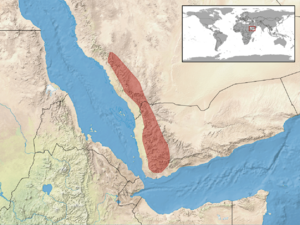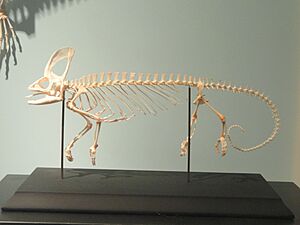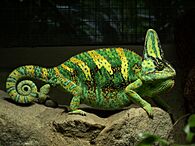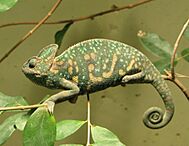Veiled chameleon facts for kids
Quick facts for kids Veiled chameleon |
|
|---|---|
 |
|
| Conservation status | |
| Scientific classification | |
| Genus: |
Chamaeleo
|
| Species: |
calyptratus
|
 |
|
The veiled chameleon (Chamaeleo calyptratus) is a cool type of chameleon. It lives naturally in the Arabian Peninsula, specifically in Yemen and Saudi Arabia. People also call it the cone-head chameleon or Yemen chameleon.
When they are born, veiled chameleons are a light green color. They don't have the big bump on their head, called a casque, yet. As they grow up, this casque gets bigger, and their colors become much brighter. These chameleons can change their colors for many reasons. They might change color to show they are angry, to show their place in a group, to find a mate, or when they are feeling stressed. Female veiled chameleons usually live for about five years, while males can live up to eight years. They lay eggs a few times each year.
Contents
What's in a Name?
The name 'veiled chameleon' comes from the special bump on their head. This bump looks a bit like a veil. The word 'chameleon' comes from old Greek words meaning 'low to the ground' and 'lion'. So, it's like a tiny lion that stays close to the ground! The scientific name, calyptratus, also means 'veil' or 'cover' in Greek. This refers to their unique head bump. This casque helps them by guiding dew and rainwater right into their mouths, helping them drink.
Meet the Veiled Chameleon
Male veiled chameleons can grow to be about 43 to 61 centimeters (17 to 24 inches) long. This measurement is from their nose to the tip of their tail. Females are a bit shorter, usually around 35 centimeters (14 inches) long. However, females have a thicker body than males. Both male and female chameleons have a casque on their head. This casque gets bigger as they get older. In very old chameleons, it can be about 5 centimeters (2 inches) tall.
When baby chameleons hatch, they are a light, soft green color. As they mature, they start to get stripes and many different colors. Adult females are green with spots of white, orange, yellow, or tan. Adult males are much brighter. They have clear bands of yellow or blue, along with some spots.
Many things can make a chameleon change its color. For example, their social status can affect it. Young chameleons raised alone often look darker and duller. Chameleons also turn a much darker color when they are stressed or scared.
Types of Veiled Chameleons
There are two main types, or subspecies, of veiled chameleons:
- Chamaeleo calyptratus calyptratus – This is the regular veiled chameleon.
- Chamaeleo calyptratus calcarifer – This one is called the short-casqued chameleon.
Where They Live
The veiled chameleon lives mostly in trees and plants. They are from the southwestern part of the Arabian Peninsula. This area has a climate that is dry but also has some tropical parts. These chameleons can get stressed easily, which makes them tricky to care for as pets.
In their natural home, they live in different places. These include flat areas called plateaus, mountains, and valleys. Like most chameleons, they love living in trees and large plants. They prefer warm weather, usually between 24 and 35 degrees Celsius (75 and 95 degrees Fahrenheit).
What They Eat
Veiled chameleons mainly eat insects. They can catch large bugs, but they usually eat smaller ones. Interestingly, they are one of the few chameleon types that also eat plants. Scientists think they might eat plants to get water during dry times.
Behavior and Life Cycle
Reproduction and Life Cycle
Veiled chameleons are ready to have babies when they are about four to five months old. They can breed several times a year. A female chameleon lays many eggs, sometimes up to 85 at once! These eggs are white and tough. She buries them in the sand.
The baby chameleons inside the eggs go through a resting period. This is called a diapause. They stay dormant for about 60 to 75 days before they start to grow. Warmer temperatures in the sand help them begin to develop.
A study in 2004 found something interesting. Chameleon eggs sometimes stop developing for months after they are laid. This happens at an early stage called the gastrula stage. The study showed that how much moisture is in the sand doesn't really matter. But the temperature plays a big role. When it gets warmer, the resting embryos start to grow again.
Young chameleons grow very fast. Their feeding parts, like their mouth, tongue, and jaw, grow quickly. This means they need to keep eating while they are growing. Male chameleons usually live longer than females. Even with good care, veiled chameleons only live about 6 to 8 years because they have a naturally short lifespan.
How They Use Color to Communicate
Chameleons use their amazing color changes to talk to each other. This helps them avoid fighting unnecessarily. When a chameleon is calm, its colors stay the same. But if it's about to fight, its colors will change quickly.
Veiled chameleons often get brighter before approaching another chameleon. This is a sign that they are ready to fight. They also make their stripes as bright as possible. This shows how strong their bite is. The brighter and longer the stripes stay, the stronger the bite. This helps chameleons decide if they should fight or not. It saves them time and energy if they can tell who is stronger without a real fight. Brighter, more yellow stripes also mean more aggression.
Bright head colors often mean a chameleon is more likely to win a fight. How fast they change color also shows how a fight might end. Veiled chameleons were among the first animals studied for how fast they change color, not just how bright. Male veiled chameleons can be very aggressive. Before a fight, they often change colors from a distance. This lets them check out the other chameleon's colors. When they get close, they face each other head-on. This gives them a clear view of the other's head colors.
All chameleons can change color using special cells in their skin. These cells have tiny crystals. Veiled chameleons have two layers of these cells. This two-layer system helps them camouflage and also send signals. It might even help protect them from the sun's heat.
Mating Rituals
When male chameleons want to mate, they put on a show for the females. They do things like "head rolls" and rub their chins. Females change their color when they are ready to mate. Males are more likely to try to mate with them at this time.
Females are ready to mate when they get pale-blue spots on their backs. They go through regular cycles of laying eggs, which is linked to their hormones. Male courtship involves showing off bright colors, flattening their bodies, swaying, and curling their tails.
Parental Care in Captivity
After mating, a female chameleon in captivity will eat less for three to four weeks. She will spend more time at the bottom of her cage looking for a good spot to lay eggs. She usually digs tunnels deep down and covers them up. This makes the eggs hard to find. A female might dig another tunnel and lay more eggs about a week later. It's important to give females easy ways to get from high places in their cage to their egg-laying tunnels.
If you are raising them in captivity, the eggs should be carefully dug up. Then, they are put into plastic containers with a mix of vermiculite and water. The eggs should be buried halfway, about 1 to 1.5 inches deep. They should be placed about 0.5 to 1 inch apart because they might absorb water and get bigger. Baby chameleons start growing faster if the eggs are kept warmer. How much moisture there is doesn't seem to matter as much. Eggs should be kept at 26 to 30 degrees Celsius (79 to 86 degrees Fahrenheit) with 95% humidity.
Once hatched, baby chameleons should stay in their container for at least a day. Their first homes should be small aquariums with screen tops. The bottom should be filled with artificial plants. Two to six babies can live together for the first few months. When they are about 4 to 6 inches long, they should be moved to bigger enclosures with more plants. They can be kept alone once they are 4 to 6 months old.
Health Problems
Like many reptiles, veiled chameleons can get eye infections. They can also get bumps under their skin. These bumps can be from infections, parasites, or sometimes even tumors.
Young veiled chameleons kept as pets often get a bone disease. This happens if they don't get enough calcium and vitamins A and D. They also need special UVB light to stay healthy.
Chameleons in captivity can also get other problems. These include too little or too much vitamin A, kidney failure, or trouble laying eggs. They can also have breathing problems if the humidity isn't right. Parasites and mouth problems are also common. Too much UVB light can even hurt their eyes.
There's a virus called serpentovirus that causes breathing problems in snakes. Veiled chameleons have shown similar signs, like sneezing, being tired, having mucus in their mouths, and looking unwell. Young chameleons seem to get sicker from this virus and can die faster.
Keeping Veiled Chameleons as Pets
The veiled chameleon is the most popular chameleon to keep as a pet. People have been keeping and breeding them for almost 30 years. They are more able to handle living as pets than other chameleon types. However, they are still challenging pets to keep healthy.
Caring for Your Veiled Chameleon
Veiled chameleons need very specific care to stay healthy. It's important to know that pet chameleons should never be let go into the wild. They are an invasive species and can harm local wildlife. If you can no longer care for your chameleon, find a reptile rescue group.
Your chameleon needs a tall, roomy cage with lots of places to climb. Since they live in trees, an adult chameleon needs a cage at least 2 feet by 2 feet by 4 feet. It should have many vines for climbing. They also need a warm spot to bask, around 32–35 degrees Celsius (90–95 degrees Fahrenheit). There should also be a cooler area, about 21–27 degrees Celsius (70–80 degrees Fahrenheit). Veiled chameleons also need special full-spectrum UVB lighting. This light helps their bodies use calcium correctly.
Veiled chameleons eat insects. Their diet should include live insects like crickets, roaches, and mealworms. You should dust these insects with calcium powder. Chameleons need regular access to water for drinking and for humidity. You should mist their cage several times a day to keep the humidity right. Also, provide a dripper or other source of running water, as chameleons drink water droplets.
Research on Chameleons
Chameleons have special body parts for living in trees. These include split hands and feet for gripping, a tail that can grab things, a tongue that shoots out, eyes that move separately, and flat bodies. Because of these unique features, the veiled chameleon is becoming important for studying how animals' bodies work and how they develop over time. In 2019, scientists created a detailed map of the veiled chameleon's genes. This helps them learn more about how chameleons evolved and developed.
The veiled chameleon is also used to study how reptiles changed into mammals and birds. Most reptiles are quite developed when they hatch. But veiled chameleons are different. They breed easily and lay many eggs (45–90) several times a year. This makes them great for studying how animals develop and evolve.
Young chameleons have different kinds of teeth. Some teeth are simple, and others have multiple points. Chameleon teeth are attached directly to their jawbones. This makes them useful for studying how teeth connect to bone.
Invasive Species Alert
The veiled chameleon has become an introduced species in Hawaii. Here, it is an invasive species and harms the local ecosystem. There's a group of them living and breeding on the island of Maui. They can also be found in the wild in Florida, where escaped pets have started new populations.
Since veiled chameleons are becoming an invasive species, they are hurting many native animals and plants in Hawaii. These chameleons mainly eat native Hawaiian insects. They also eat native plants like lehua, koa, and hala. They even eat small lizards, such as the mourning gecko and the gold dust day gecko.
Veiled chameleons can lay 30 to 95 eggs up to three times a year. Their eggs hatch in only six months. They can live for 4 to 8 years. Their fast breeding and ability to eat native Hawaiian birds and insects are a big worry. They can also live in many different places, from dry sea level areas to wet mountains up to 12,000 feet high.
People are working to control the veiled chameleon population in Hawaii. One way is to catch and remove them from the wild, especially where they are breeding. There are also programs to teach people not to release non-native pets into the wild.
The veiled chameleon's arrival in Hawaii has a bad effect on the ecosystem. They eat many different things, compete with native species, and breed quickly. This can lead to too many chameleons. Strong actions are needed to control their numbers.
In 1992, a law was made in Hawaii. It became illegal to bring in, own, or move veiled chameleons without a special permit. This law helps the Hawaii Department of Agriculture stop more invasive species from coming in. Owning or bringing in veiled chameleons without a permit can harm Hawaii's ecosystem and its many different types of life, called biodiversity. Enforcing this rule helps protect Hawaii's natural resources and its unique culture. Breaking this law can lead to fines, jail time, and your chameleon being taken away.
Amazing Adaptations
Veiled chameleons have many cool ways they have adapted to survive. They are famous for changing their color to blend in with their surroundings. They can change color based on their environment, their mood, and the temperature. For example, they turn black or gray when they are upset. They use camouflage to hide from predators and to hunt their prey more easily.
They also have a special tail called a prehensile tail. This tail helps them grip and hold onto branches and other surfaces. This adaptation helps them move easily through trees and avoid falling.
Veiled chameleons have a long, sticky tongue that can be twice as long as their body! This helps them catch insects from far away. They also have "turret eyes." This means their eyes can move separately from each other. Their eyes can see a full 360-degree view around them. This helps them spot dangers more effectively.
Their feet are also unique, called zygodactylous feet. Their toes are arranged in two groups that face each other. This gives them a very strong grip on branches, keeping them stable as they move. Veiled chameleons also have a hooded head. This hood helps them collect water. When water droplets land on their hood, they slide down into the chameleon's mouth. The male chameleon's hood also plays a role in reproduction. Males have a pointier hood than females. Males might use their hoods to fight each other when trying to mate with a female. Females often prefer males with a large hood because they look more intimidating. This helps pass on the genes for a large hooded skull to their offspring.
Chameleons in Culture
The veiled chameleon is the logo for the SUSE Linux computer operating system. The very first known description of a chameleon was written by a famous thinker named Aristotle a long, long time ago.
Images for kids










